Chitwan - Authentic Tharu Culture and Wildlife Safaris
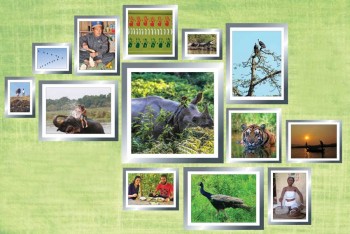
.jpg) Located at the heart of Nepal is a jungle that is known best for its diverse wildlife, safaris and the culture of the local Tharu tribe.
Located at the heart of Nepal is a jungle that is known best for its diverse wildlife, safaris and the culture of the local Tharu tribe.
Think of wildlife in Nepal and the first place that comes into mind is Chitwan National Park. Indeed, out of more than 20 protected natural areas of Nepal, Chitwan National Park is the most popular destination as it is one of the easily accessible regions. It also happens to be the first national park established in Nepal. Covering four districts of Nepal, Parsa, Nawalparasi, Makwanpur, and the majority of Chitwan, this national park spans over 932 square km and is inhabited by over 700 species of wildlife including mammals, birds, and reptiles.
 If you’re planning to get to Chitwan by air, a 20-minute flight from Tribhuvan International Airport will land you in Bharatpur, the district headquarter of Chitwan. Book your flight tickets to Bharatpur, Chitwan with Buddha Air as now we have 8 daily flights to this beautiful destination.
If you’re planning to get to Chitwan by air, a 20-minute flight from Tribhuvan International Airport will land you in Bharatpur, the district headquarter of Chitwan. Book your flight tickets to Bharatpur, Chitwan with Buddha Air as now we have 8 daily flights to this beautiful destination.
A city that falls among the four metropolitan cities in Nepal; Bharatpur is the gateway to many areas of Chitwan National Park where you can discover the unique wildlife and vegetation of Nepal’s terai region. The city is bordered by two major rivers Narayani and Rapti that play a vital role in the ecosystem of the national park. Take a trip to Bharatpur as the city unfolds countless attractions, from elephant breeding centers, jungle safaris and lodging in the jungle to vulture restaurants and discovering the Tharu culture. Bharatpur is definitely where the wild things are.
We present you with a four-day itinerary to help you get the most of your trip to Bharatpur and Chitwan National Park.
Day 1: Bharatpur - Amaltari
A 20 minute flight onboard Buddha Air will land you in Bharatpur Airport. Make sure to catch the morning flight to make most of the day. A short flight means more time to enjoy the spectacular activities in the destination. While flying, if you’re lucky to get a seat in the right side of the plane, enjoy the vast Himalayan range from the window. It spans as far as the eye can see. You can also look down to enjoy the changing landscapes. From Kathmandu Valley’s plains to green hills and then the plains of terai, the entire flight is a thrilling way to enjoy the diverse geography of the country. When the aircraft makes its descend, you actually fly over the national park, with just enough time to admire the vastness of the forest.
Once you land in Bharatpur airport, head over to Amaltari, an hour drive about 49 km from the airport. Amaltari falls in the western part of the Chitwan National Park. Once you’ve checked into the hotel, head out for a jungle safari. Jungle safaris are provided by the hotel itself so make sure to book a jungle safari when booking your room at a hotel. A walk through the jungle with all its sights and sounds is certain to bring out the explorer in you.
Make sure to keep your senses aware of any movements or sounds of animal and bird calls. A binocular and a camera with a good lens are good gadgets to carry with you while on the move. During the safari, look out for some common animal sightings such as the Indian hog deer, spotted deer, wild boar, rhinoceros, and birds such as the peacock, storks, and ruddy shelduck.
After an exciting time in the jungle, you can either choose to return to the hotel or stay by the banks of the Narayani River to enjoy a beautiful sunset over the jungle. This scenic view is best seen from the river bed. Relax as you unwind for the day, and then retire to the hotel.
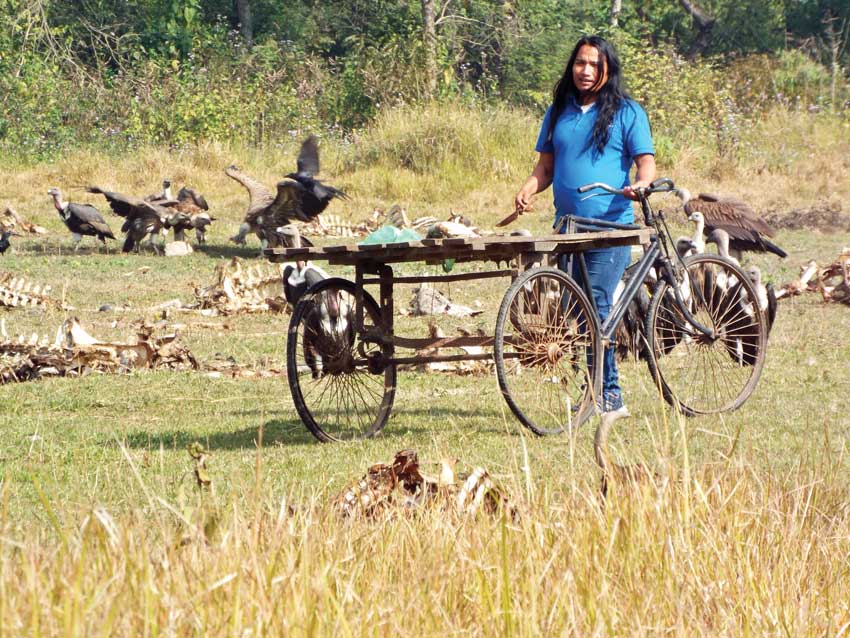
Day 2: Amaltari – Paithani
Wake up early and prepare for a day of adventure. After a hearty breakfast at the hotel, head over to Jatayu Vulture Restaurant in Pithauli, located about 17 km from Amaltari. Don’t be deceived by the center’s name. This isn’t a place where they serve vultures! On the contrary, it is a feeding ground for the white-rumped vultures, an endangered species in the Chitwan National Park. The vulture restaurant has been established to help conserve the population of this endangered species.
Enjoy your time at the Jatayu restaurant as you learn about the conservation measures taken to help preserve the wildlife of the national park. You’ll be in awe at the power of nature! These vultures are said to be able to turn the corpse of an adult cow into bones in just 20 minutes! A trip to Jatayu Vulture Restaurant will definitely bring awareness about the need for conservation of the eco-system. After a thrilling experience at Pithauli, head east to Kasara in Paithani. The route is about a two hours drive. Bharatpur lies halfway along the route then you turn south and drive for one hour to the destination.
Paithani has recently made a mark on the map as a must-stop itinerary when visiting Chitwan National Park. Located in  the banks of Rapti River, along the border of Chitwan National Park, Patihani is peaceful and boasts some of the best sunsets in the region. Once you reach here, check into your hotel and stop for lunch then head out for an elephant safari. Most lodges and resorts provide elephant safaris upon arrival or you can also book a safari while looking for a resort. Moving towards the elephant safari will take a 10-minute jeep ride across the villages of Patihani. This is a great chance to observe the village life as well as the nearby banana cultivations. Towards the north, you can view the mountains of the Manaslu range on a clear day. Once you reach to the safari point, ride the elephant and head towards the jungle. Again, keep an eye out for sights and sounds and make sure to carry binoculars with you. To get the best of the elephant safari, head out in the late afternoon when the animals move towards the riverbed for water. Again, you can spot animals such as herds of spotted dear, hog dear, and even wild cats, rhesus monkeys as well as wild boars and birds such as open-billed stork and peacocks. Enjoy the tranquil ride on a gentle giant as the sun sets over the horizon and you enjoy the best of Chitwan National Park, from dense jungle and abundant wildlife to breathtaking scenes of the sunset and the Himalayan range in the distance.
the banks of Rapti River, along the border of Chitwan National Park, Patihani is peaceful and boasts some of the best sunsets in the region. Once you reach here, check into your hotel and stop for lunch then head out for an elephant safari. Most lodges and resorts provide elephant safaris upon arrival or you can also book a safari while looking for a resort. Moving towards the elephant safari will take a 10-minute jeep ride across the villages of Patihani. This is a great chance to observe the village life as well as the nearby banana cultivations. Towards the north, you can view the mountains of the Manaslu range on a clear day. Once you reach to the safari point, ride the elephant and head towards the jungle. Again, keep an eye out for sights and sounds and make sure to carry binoculars with you. To get the best of the elephant safari, head out in the late afternoon when the animals move towards the riverbed for water. Again, you can spot animals such as herds of spotted dear, hog dear, and even wild cats, rhesus monkeys as well as wild boars and birds such as open-billed stork and peacocks. Enjoy the tranquil ride on a gentle giant as the sun sets over the horizon and you enjoy the best of Chitwan National Park, from dense jungle and abundant wildlife to breathtaking scenes of the sunset and the Himalayan range in the distance.
After the safari that lasts about three hours, head back to the resort and enjoy its amenities. Most resorts offer a slideshow presentation of the national park and you can get to know the list of birds and animals that call the national park home. Along with that, you also get a chance to learn more about the history of the national park.
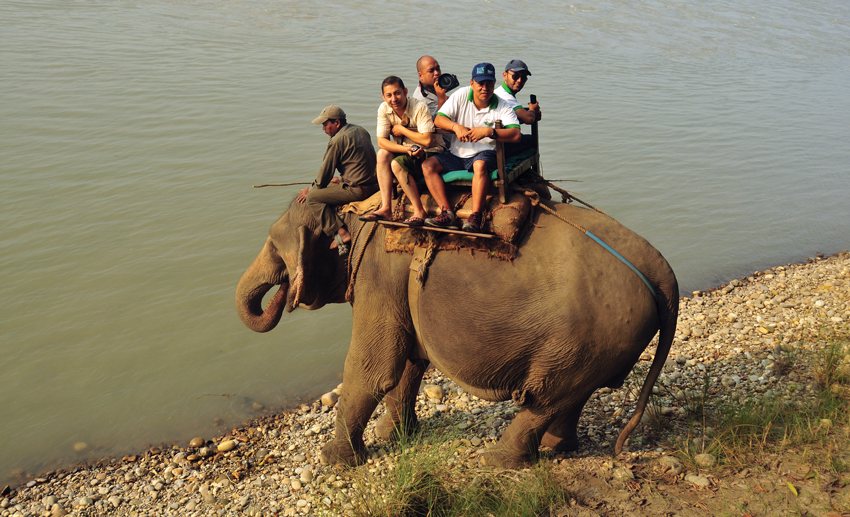
Day 3 – Paithani to Sauraha
Day 3 starts with breakfast at Paithani. After breakfast, take a boat ride across the Rapti River that will land you on the banks of Chitwan National Park. Take a guide with you and a short hike about 15 minutes to the Crocodile Breeding Center. This breeding center houses over 1500 gharials as young as a few weeks old to fully matured gharials spanning over 7 feet in length. The breeding center has been able to protect the endangered species. It also has an area designated for tortoise breeding as well as vulture breeding. However, only the gharial and tortoise breeding centers allow visitors. Since the breeding center lies within the National Park, you can also take a walk or a jeep ride while in the park.
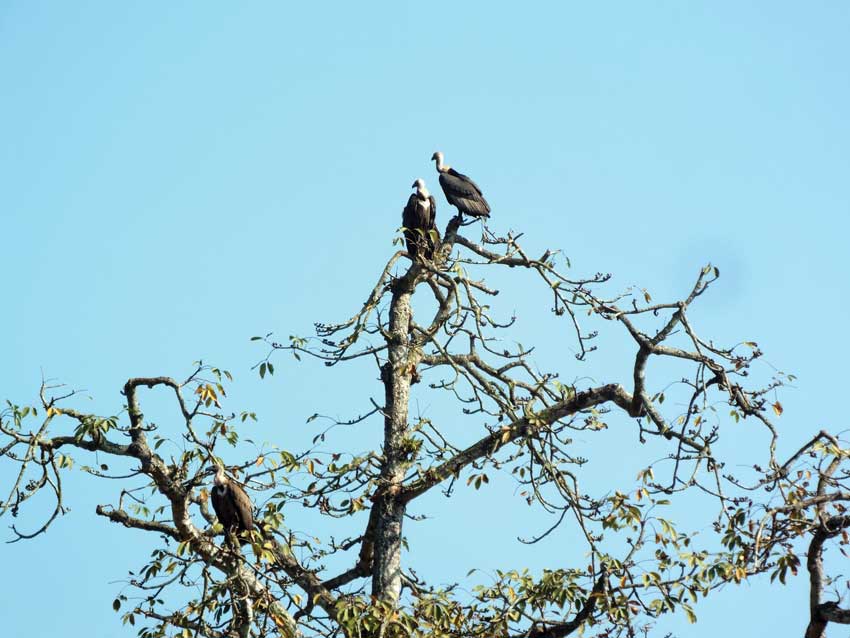
After a visit to the breeding center, it takes an hour-long drive to reach Sauraha. Check into the hotel and enjoy a hearty lunch. Enjoy walking the streets of Sauraha, where you can see traditional “tangas” (a carriage that is pulled by horses) passing by. You can catch a ride in one of the tangas and explore Sauraha as it is also a great place to buy souvenirs from your trip to Chitwan National Park. Some of the notable souvenirs include animal figurines carved out of wood or natural honey sold in shops. You can also buy t-shirts and other hand-made merchandise made by local Tharu women.
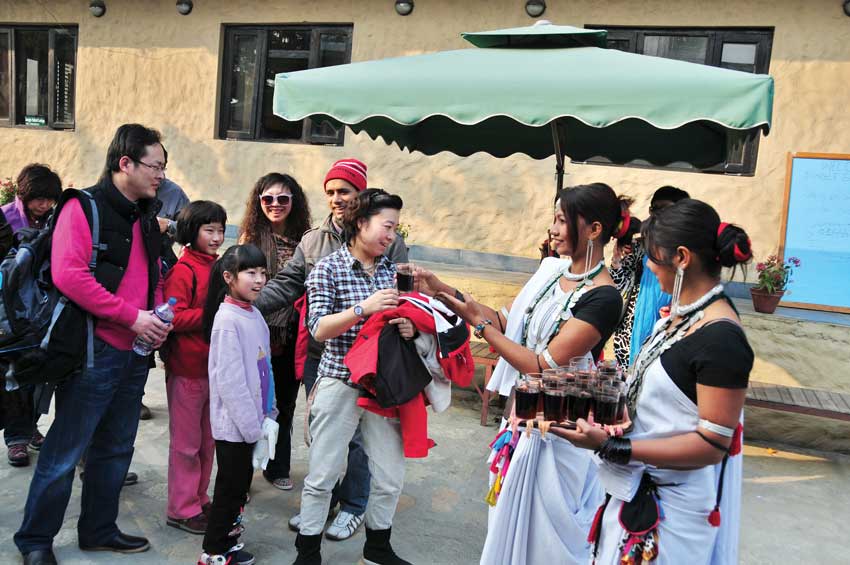
In the afternoon, enjoy a visit to the Tharu Museum nearby. Depending on the place that you are staying, the Tharu Museum will take about a 5-10 minutes’ drive. The museum holds exhibitions and research done about the Tharu community; natives of the Terai region that are found mostly in the areas of Chitwan National Park. Some of the highlights of the museum include paintings depicting the daily lifestyle of the Tharu people, sculptures that represent their traditional dress, and a gallery of traditional utensils and cooking wares. After gaining some information about the Tharu people of Nepal, head back to the hotel where a Tharu culture show will be waiting for you. The Culture Show consists of traditional Tharu dances, including Danda Nach (stick dance), Mayur Nach (peacock dance), and Aago Nach (fire dance). With new-found knowledge about the local Tharu community, you are certain to appreciate the cultural show even more.

Day 4 – Sauraha – Bharatpur
The trip to Chitwan National Park comes to an end on the fourth day. Before heading out to Bharatpur to catch your flight, you have just enough time to check out the Elephant Breeding Center at the edge of the National Park. Located about 6 km away from Sauraha, it takes about 15 minutes to reach the center on a tempo.
The breeding center is located close to the forest so that wild male elephants can visit to conceive the female elephants in the center. It goes without saying that the breeding center only houses the female elephants and their offspring. Most of the elephants leave the center to provide jungle safaris or to gather food during the afternoon. Thus, it is advised to visit the center early in the morning when all the elephants are present in their tents. You will be thrilled at the sight of young, playful elephants that stay close to their mothers. Start a conversation with the local caregivers and they will tell you the tale of Ronaldo, the infamous wild elephant bull that visits the center often. Most of the elephants born in the center happen to be his offspring. However, the center is lined with electrical wires to discourage Ronaldo from crossing over to the villages and creating havoc. The center and its elephants are well taken care of by the caregivers and it even houses a small exhibition of the center’s history and elephant’s skulls on display.
This concludes your trip to Chitwan National Park. And we hope that when you check out of your hotel in Sauraha and return towards home, you have received a newfound love and admiration for the oldest national park in Nepal, which is full of wildlife and of course the iconic elephants, that are truly the backbone of Chitwan National Park.
Chitwan National Park Facts:
Area: 932 sq km
Date of Establishment: 1973 AD
Total number of wildlife spotted: 68 species of mammals, 543 species of birds, 56 reptiles and amphibians and 126 species of fish
Common wildlife sightings: Asian one horned rhino, hog deer, spotted deer, mugger crocodile, wild boars, jungle cats, rhesus monkey, peacock, open billed stork, ruddy shelduck.
Large mammals such as the Bengal tiger and leopard are more difficult to locate since these animals are nocturnal by nature.
Best time to visit: October to February
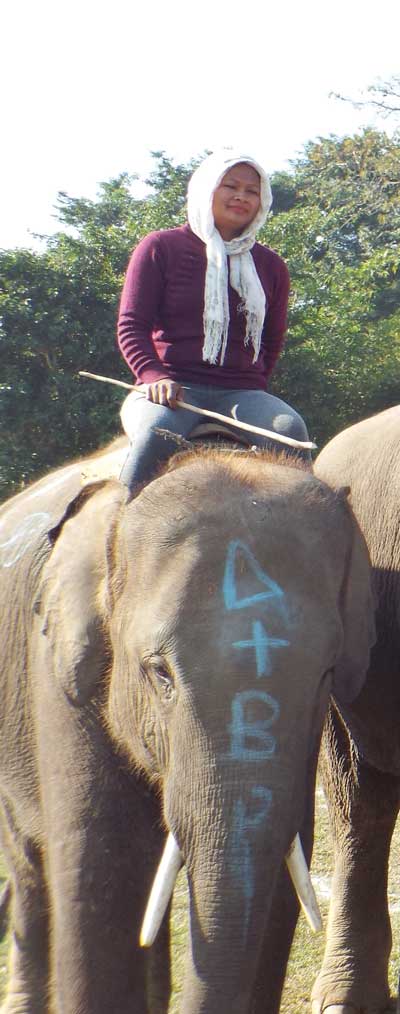 Geeta Danuwar: The Female Maute
Geeta Danuwar: The Female Maute
Very recently, Chitwan National Park has seen the emergence of female mautes. Although they are still very few in number, we had a chance to meet and strike a conversation with a female maute, Geeta Danuwar.
Maute, is the term used for elephant handlers. The mautes have a special bond with their elephants and sometimes spend a lifetime tending and riding a single elephant. The trust goes both ways as elephants generally do not obey any other human except for their maute.
Geeta Danuwar learned to become a maute by watching her husband tend and ride his elephant. A maute generally takes the responsibility of taking care of the elephant by feeding it, bathing it and taking it for jungle safaris. One day, Geeta decided that she wanted to walk on the same path as her husband. That was 6 years ago. Today, she rides the elephant as efficiently and effortlessly as any other male maute. She does not see any challenges of becoming a female maute. “There is no discrimination and nobody treats me differently. Becoming a maute just came naturally to me,” she says.
She is among the 5 female mautes currently located in Sauraha, Chitwan. Recently, Geeta participated in the Elephant Football Competition during the Elephant Festival in Sauraha. This was her first time participating in an event and indeed she was quite nervous. However, Geeta and her elephant that was the smallest in the field played efficiently and the spectators cheered her on.
“I also provide jungle safaris and I take care of the elephant by myself. I see myself working as a maute in the future and I hope more women in my community are encouraged to work as mautes as well,” she says with a big smile on her face after completing her first game in the field.
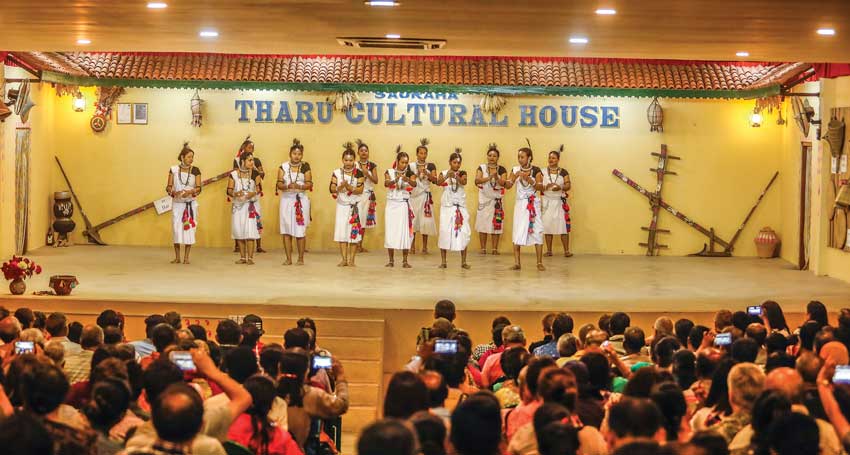
To Preserve Animals and Hospitality
Suman Ghimire, Executive Director, Jungle Safari Lodge
For over 30 years, Jungle Safari Lodge has served guests coming to Chitwan National Park. Suman Ghimire, a hotelier and current president of the Regional Hotel Association of Nepal (RHAN) shared about the future of Sauraha and the need for sustainable tourism to help both tourism and nature flourish in Chitwan National Park for years to come.
The Ratnanagar area is currently seeing a need for sustainable tourism. There are over 110 hotels in Chitwan. These hotels range in budget and the services they provide. However, Suman and RHAN are moving towards a direction where the hotels of Chitwan work together to provide similar services and hospitality. Not only this, Suman envisions a day where all safaris and lodges share similar decor of the local Tharu mud houses and Tharu art. “This will not only help to preserve the Tharu culture but will also create something unique to the region, something that will get the tourists talking,” says Suman.
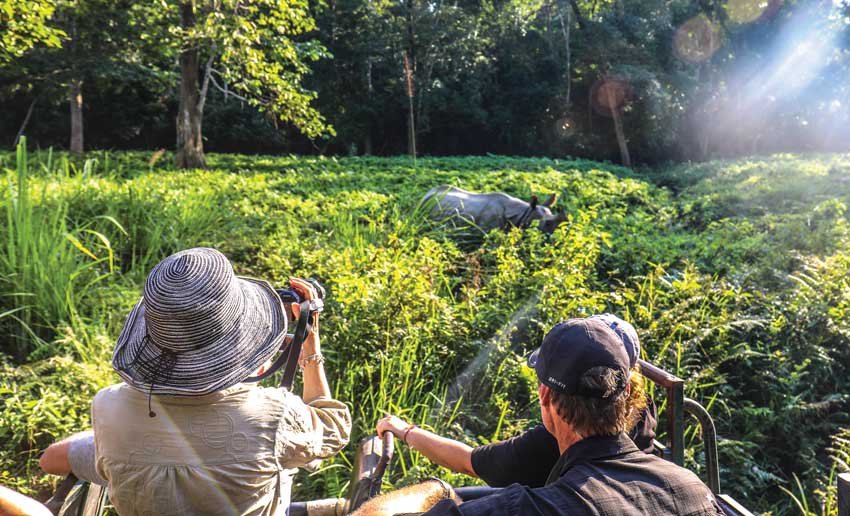
Currently, Suman as the president of RHAN was the organizer for the Elephant Festival in Chitwan in 2017. It included many attractions such as the Elephant Beauty Pageant, Elephant Polo, Elephant Football, and Elephant Picnic. These activities were done as a means to bring awareness to the local community and tourists regarding the need for the preservation of animals as well as the close relationship that these gentle giants have with humans.
Sauraha receives an equal number of foreign and national tourists and this has helped to provide employment to a lot of local manpower. With proper sustainable actions and mutual cooperation, Sauraha will be able to welcome even more guests and provide more than just the wildlife experience.
